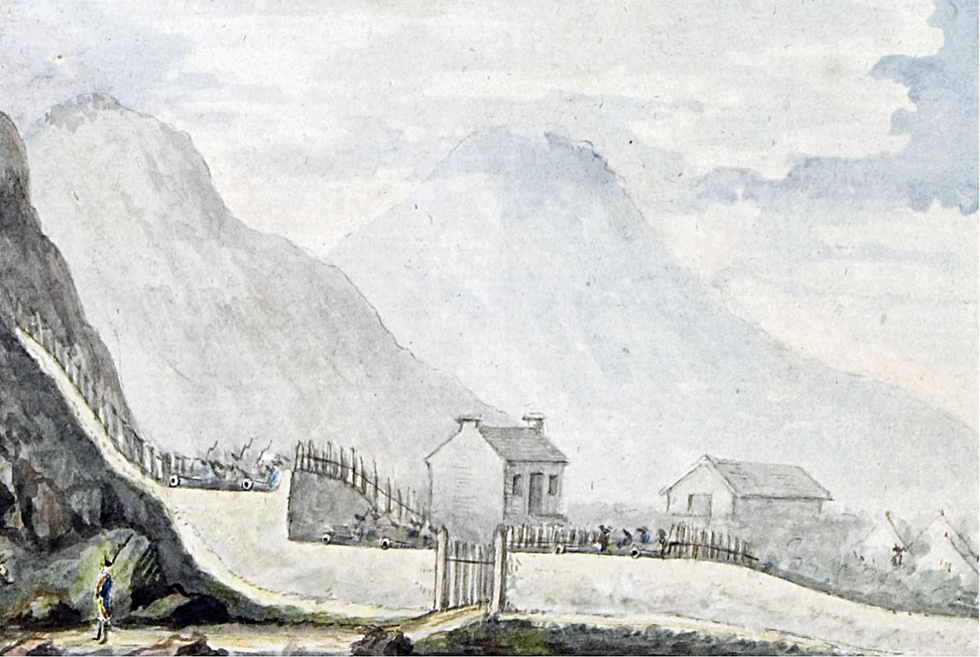Battle of Muizenberg - Seizing Cape Town
- Si Biggs

- Aug 7
- 3 min read
Unit/ Formation: Royal Marines
Location: Muizenberg
Period/ Conflict: 1700's
Year: 1795
Date/s: 7 August 1795
This was a significant military engagement which took place near Muizenberg in 1795; it led to the capture of the Dutch Cape Colony by a British Force under Major R Hill of 350 marines.
Given the turmoil in Europe and the importance of the Cape sea-route to India the British Government sent a fleet of seven Royal Navy ships under the command of Vice – Admiral Elphinstone to secure the Cape as a refreshment station and as their gateway to the East.
![View from Simon’s Town of Dutch defences at Muizenberg, 1795 Source: Hercules Ross [putative artist], courtesy of The Brenthurst Library, ART 448/4 imminent, Dundas declared that should the Dutch Republic fall, the “first act” of the new government “will be to send a French force to the Cape ... We must be beforehand with them.”!? A few weeks later, the East India Company again suggested a British take-over of the Cape since “it com- mands the paswages is and from India as effectively as Gibraltar does the Mediterranean.’](https://static.wixstatic.com/media/836e27_e4d63a1d7c2d4643b9516d17c6364170~mv2.png/v1/fill/w_980,h_688,al_c,q_90,usm_0.66_1.00_0.01,enc_avif,quality_auto/836e27_e4d63a1d7c2d4643b9516d17c6364170~mv2.png)
A small British fleet arrived in July 1795 and anchored in Simon's Bay. After unsuccessfully negotiating with the Dutch to protect the Cape from their enemies, the British landed a small army of 1,400 men and sailors and began the march on Cape Town.
On the 7th August 1795 the column marched along the coast road from Simon's Town through Fish Hoek and Kalk Bay towards Muizenberg.
Sailing along the coast next to the soldiers were 4 warships of the Royal Navy. At Kalk Bay the Dutch had a piquet of one cannon.
![Route taken by the British from Simon’s Town to Cape Town, 1795 Source: Hercules Ross [putative artist], courtesy of The Brenthurst Library, ART 448/1. That same evening, the Council of Policy signed the document and agreed to surrender the Cape. On 16 September 1795, Craig signed on behalf of the British forces and the Cape thus became British.](https://static.wixstatic.com/media/836e27_b40d1d8d6cf14be28a9833d1b43ab43f~mv2.png/v1/fill/w_980,h_616,al_c,q_90,usm_0.66_1.00_0.01,enc_avif,quality_auto/836e27_b40d1d8d6cf14be28a9833d1b43ab43f~mv2.png)
HMS America fired one gun and the Dutch retreated to their fort outside Muizenberg. At that fort 800 Dutch soldiers waited for the British. They were lightly armed but had a few cannons pointed down the road. To their surprise the four war ships anchored alongside and began firing broadsides. There was no way the Dutch could reply effectively and within a hour they had retreated around the corner to Zandvlei.

The fighting continued for some weeks, pushing the Dutch slowly back to Wynberg Hill, where a stalemate was reached.
In early September a much larger British force arrived, and with that the Dutch surrendered the Cape. Few lives were lost in the action.
At the Peace of Amiens, in 1802, one of the treaty terms returned the Cape Colony, along with all captured Dutch colonies except Ceylon, to the Batavian Republic.
The peace was short-lived, and after the outbreak of the Napoleonic Wars in 1803 a second British invasion was planned, executed in 1806 and victory secured following the Battle of Blaauwberg.
The Cape Colony remained part of the British Empire until its independence as part of a unified South Africa in 1910.
Related Royal Marines History Dits'
References/ Further Reading:
[1] South African History Online - Battle of Muizenburg Monument, Muizenburg
[2] Wikipedia - Invasion of the Cape Colony


Canduan188 | Canduan188 | Canduan188
The Battle of Muizenberg is a significant period in colonial history since it not only transformed power in the Cape but also altered trade routes to the East. Many students seek structured academic help from sites such as buy dissertation service when doing in-depth analyses of such historical occurrences.